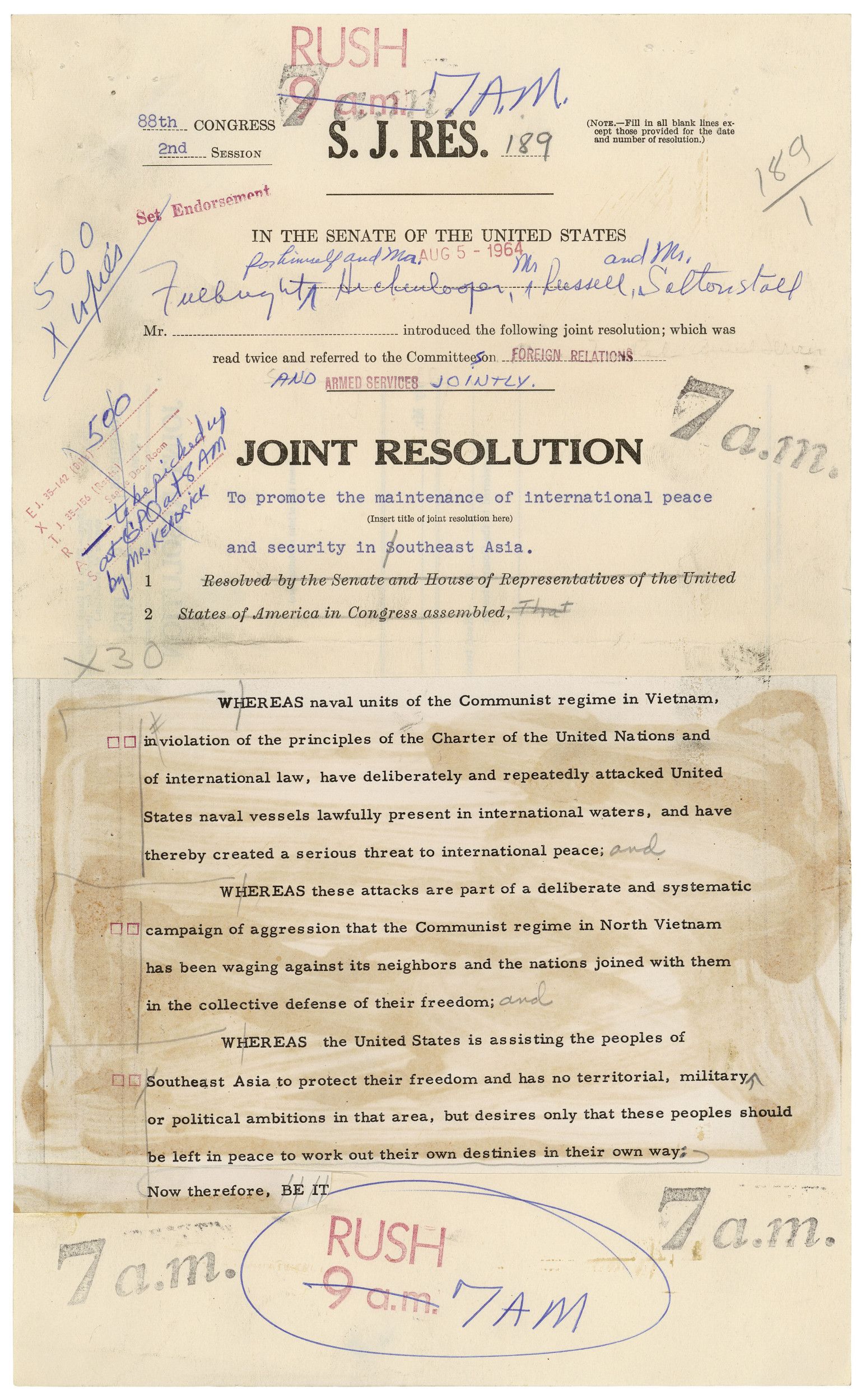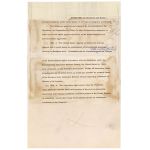Gulf of Tonkin Resolution, as Introduced
8/4/1964
Add to Favorites:
Add all page(s) of this document to activity:

Add only page 1 to activity:
Add only page 2 to activity:
On the evening of August 4, 1964, President Lyndon Johnson addressed the nation in a televised speech in which he stated that U.S. ships had been attacked twice in international waters in the Gulf of Tonkin near North Vietnam. The following morning, the Gulf of Tonkin Resolution was introduced in the Senate.
Although the version shown here is the original draft resolution, the language was not amended and therefore reads the same as the final version that was signed into law August 10, 1964. When Congress passed the Tonkin Gulf Resolution, they gave Johnson unprecedented power to “take all necessary measures to repel any armed attack against the forces of the United States and to prevent further aggression.”
There was little debate as legislators considered two incidents that had happened in the Gulf of Tonkin in the preceding days. On August 2 – the first Tonkin Gulf incident – North Vietnamese torpedo boats were spotted and attacked the destroyer USS Maddox. The Maddox was conducting electronic eavesdropping on North Vietnam to assist South Vietnamese Army (ARVN) commando raids on North Vietnamese targets, but that wasn't publicly known at the time. Historians now suspect the North Vietnamese boats had set out to attack an ARVN raid in progress when it encountered the Maddox.
On August 4, the USS Maddox captain reported a second incident, that he was “under continuous torpedo attack.” He later cabled “freak weather effects on radar and overeager sonarmen may have accounted for many reports,” but Defense Secretary Robert McNamara did not report the captain’s doubts to President Johnson. (A 2002 National Security Agency report made available in 2007 confirmed the August 2 attack, but concluded the August 4 attack never happened.)
Johnson portrayed confrontations between U.S. and North Vietnamese ships off the coast of North Vietnam as unprovoked aggression when he addressed Congress. When contrary information later surfaced, many believed Congress had been conned. It was too late.
The Gulf of Tonkin act became more controversial as opposition to the war mounted. A Senate investigation revealed that the Maddox had been on an intelligence mission in Tonkin Gulf, contradicting Johnson’s denial of U.S. Navy support of such missions. The Resolution was repealed in 1971 in an attempt to curtail President Nixon’s power to continue the war.
Although the version shown here is the original draft resolution, the language was not amended and therefore reads the same as the final version that was signed into law August 10, 1964. When Congress passed the Tonkin Gulf Resolution, they gave Johnson unprecedented power to “take all necessary measures to repel any armed attack against the forces of the United States and to prevent further aggression.”
There was little debate as legislators considered two incidents that had happened in the Gulf of Tonkin in the preceding days. On August 2 – the first Tonkin Gulf incident – North Vietnamese torpedo boats were spotted and attacked the destroyer USS Maddox. The Maddox was conducting electronic eavesdropping on North Vietnam to assist South Vietnamese Army (ARVN) commando raids on North Vietnamese targets, but that wasn't publicly known at the time. Historians now suspect the North Vietnamese boats had set out to attack an ARVN raid in progress when it encountered the Maddox.
On August 4, the USS Maddox captain reported a second incident, that he was “under continuous torpedo attack.” He later cabled “freak weather effects on radar and overeager sonarmen may have accounted for many reports,” but Defense Secretary Robert McNamara did not report the captain’s doubts to President Johnson. (A 2002 National Security Agency report made available in 2007 confirmed the August 2 attack, but concluded the August 4 attack never happened.)
Johnson portrayed confrontations between U.S. and North Vietnamese ships off the coast of North Vietnam as unprovoked aggression when he addressed Congress. When contrary information later surfaced, many believed Congress had been conned. It was too late.
The Gulf of Tonkin act became more controversial as opposition to the war mounted. A Senate investigation revealed that the Maddox had been on an intelligence mission in Tonkin Gulf, contradicting Johnson’s denial of U.S. Navy support of such missions. The Resolution was repealed in 1971 in an attempt to curtail President Nixon’s power to continue the war.
This primary source comes from the Records of the U.S. Senate.
National Archives Identifier: 2127364
Full Citation: Gulf of Tonkin Resolution, as Introduced, S.J. Res. 189; 8/4/1964; (SEN88A-B2); Bills and Resolutions Originating in the Senate, 1789 - 2002; Records of the U.S. Senate, Record Group 46; National Archives Building, Washington, DC. [Online Version, https://docsteach.org/documents/document/tonkin-resolution, April 16, 2024]Activities that use this document
- Analyzing the Gulf of Tonkin Resolution (Original Draft Resolution)
Created by the National Archives Education Team - Gulf of Tonkin Incident and Resolution
Created by the National Archives Education Team - Separation of Powers or Shared Powers
Created by the National Archives Education Team
Rights: Public Domain, Free of Known Copyright Restrictions. Learn more on our privacy and legal page.


